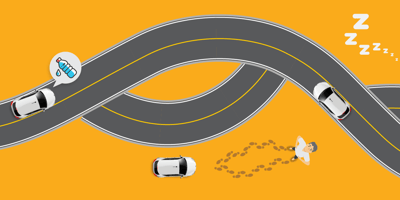In the fast-paced world of gig economy delivery, your vehicle becomes your office, and time is of...
The future of on-demand: Where are we going, and are we getting a Lyft?
Re-post from Techcrunch. Posted the 2nd of March of 2016 by Ash Rust: http://techcrunch.com/2016/03/01/the-future-of-on-demand-where-are-we-going-and-are-we-getting-a-lyft/
If the on-demand economy was a young pup in the late 2000s, then it has since evolved into a much more sophisticated animal: strong, resilient and capable of adapting to its environment.
This movement was bred from the human desire for immediacy. Agile startups evolved quickly with real-time feedback, all conjoined by the central pillar of this new industry: the smartphone.
The on-demand world
When we need to get somewhere, we call an Uber or a Lyft. We all need groceries, but we’d happily pay to avoid spending hours in the grocery store each week, so Instacart allows us to choose and receive our groceries with an app. When we feel ill, we use ZocDoc to schedule an appointment with a doctor. But that’s just the start.
Want a tailored outfit? Call Trumaker, and it’ll send someone over to get you measured. With new clothes, you’ll need to do laundry. Washio is here: It’ll take your dirty clothes, launder and fold them, and bring them right back to you.
On-demand services even exist for your pets, such as Wag! dog walking. And if you can’t be the kids’ chauffeur today, Shuddle is here to deliver them safely wherever they need to go.
On-demand growing pains
On-demand transport, healthcare and grocery delivery are popular because they make consumers’ lives easier. But on-demand businesses hardly have it easy: Despite at least $9.4 billion being invested in the on-demand economy since 2010, on-demand businesses are subject to failure like any other startup. And on-demand companies’ thin margins — due to their business models and substantial labor needs — mean they generate less profit per transaction to address these challenges.
First, the hiring process is overwhelming. Uber’s success hinges on the availability of drivers, who numbered 327,000 by fall 2015. On-demand services require a lot of manpower, making it crucial to recruit efficiently, process applications quickly and complete thousands of background checks.
Additionally, many full-time employees — who form more than 80 percent of the U.S. workforce — don’t want to freelance. On-demand employers must offer competitive compensation to attract high-quality, trustworthy people who care about those companies. Of course, on-demand brands must compete against one another for workers, too.
Hiring contract employees rather than full-timers is a good way to limit costs and improve those thin margins, but it comes with some legal gray area, as employment laws were inked long before the rise of on-demand businesses. Many services, such as Instacart, aren’t awaiting legal judgments and are proactively employing contractors. However, only larger, more mature companies may be able to bear this expense.
Communication is one of on-demand’s biggest challenges. When a customer expects something in minutes, on-demand companies can’t afford to keep them waiting. A complex network of triage and backup is required for almost every on-demand service.
Another logistical issue is proximity. On-demand services must be near users, wherever they may be. Maintaining a company headquarters and hiring representatives for every city of operation can be exorbitantly expensive. For on-demand services, profitability requires significant scale in areas with high population densities.
But logistical challenges are just that: challenges. Pioneering on-demand companies have already conquered these challenges, and that’s emboldening up-and-coming startups. The blossoming economy is also providing tools to make the journey easier for on-demand startups. Checkr, for instance, enables discreet, on-demand background screenings and driving-record checks via a developer-friendly platform.
Infiltration of new markets
Not without its detractors, the new economy faces challenges from entrenched industries, labor costs and logistical needs. However, in less than five years, on-demand has gone from an economist’s pipe dream to permeating our everyday lives. We’ve just begun to scratch the surface, so what’s in store next?
Because on-demand services can be priced affordably, even brands unassociated with the on-demand movement want to join in. For instance, Taco Bell, which has long resisted delivery, now allows customers to order food any time, anywhere, and have it delivered via DoorDash. Beyond fast food, Magic can deliver anything — from a toothbrush to airline tickets.
Services that aren’t necessarily obvious on-demand candidates will also be infiltrated. Wag! is growing rapidly — but who would’ve guessed 10 years ago that on-demand dog walking would be a viable business?
New spins on old ideas
BloomThat has cropped up to offer flower delivery within hours, while Lugg lends an on-demand hand for furniture moving and Luxe can help take the stress out of parking. While flower delivery and valet parking aren’t new, the on-demand economy is reimagining them by making these services more convenient, more affordable and available with a few taps.
Consolidation and aggregation
As the economy matures, more successful companies will consume smaller ones. Look at the consolidation we saw in the daily deals space. During 2010 and 2011, Groupon acquired seven companies, mostly to fuel its global expansion. LivingSocial, a perennial No. 2 in the space, acquired eight companies in the same period; most were international and offered daily deals. Thin margins tend to breed a winner-takes-all environment.
Some companies will handle multiple on-demand services at once. Already, Your Mechanic will go to your car, change its oil and replace its wipers. But what if you could outsource all your motoring needs? This hypothetical app might obtain insurance quotes; offer small, on-demand repairs; contact a garage for in-depth service; and even help you sell your car.
Great challenges lie ahead in the on-demand economy, but great accomplishments lie in its wake.
The Industrial Revolution spanned centuries; America’s transition from a manufacturing economy to a service economy took between a quarter- and half-century. Now, in less than a decade, on-demand brands have become household names, and more than one-third of U.S. workers are freelancing.
Nobody’s quite sure where on-demand is headed, but one thing is clear: On-demand is building a bridge to a more efficient time — one when we ask for things only when we actually need them.


